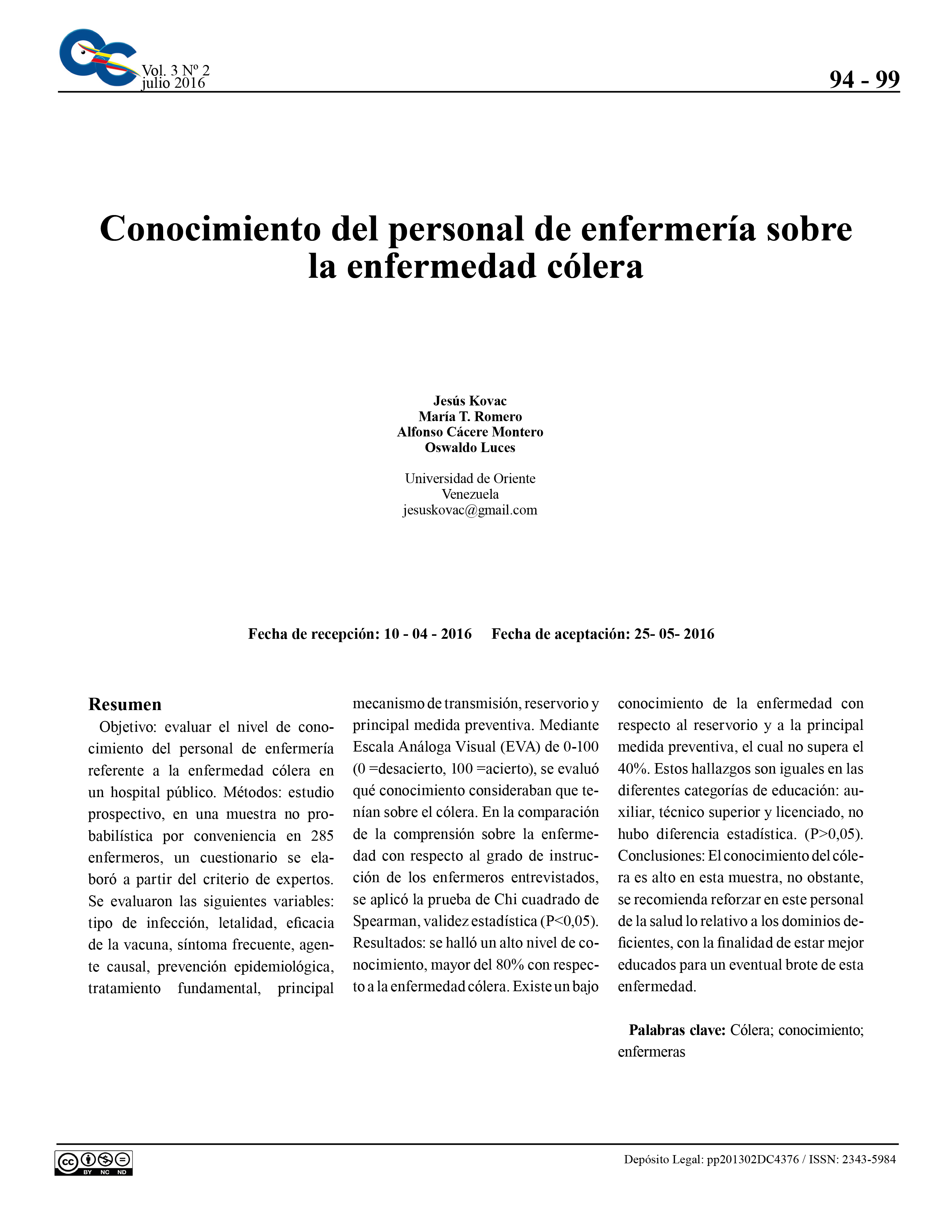Nursing staff knowledge of cholera disease
Keywords:
Cholera, ; knowledge, nursesAbstract
Objective: to assess the level of knowledge of nursing staff regarding cholera disease in a public hospital. Methods: Prospective study, in a non-probabilistic sample for convenience in 285 nurses, a questionnaire was elaborated from the criteria of experts. The following variables were evaluated: type of infection, lethality, vaccine efficacy, frequent symptom, causal agent, epidemiological prevention, fundamental treatment, main transmission mechanism, reservoir and main preventive measure. By means of a Visual Analog Scale (VAS) of 0-100 (0 =failure, 100 =failure), it was evaluated what knowledge they considered they had about cholera. In the comparison of the understanding of the disease with the degree of education of the interviewed nurses, the Spearman's Chi-square test, statistical validity (P<0.05), was applied. Results: A high level of knowledge, greater than 80%, was found with respect to cholera. There is a low knowledge of the disease with respect to the reservoir and the main preventive measure, which does not exceed 40%. These findings are the same in the different education categories: assistant, superior technician and graduate, there was no statistical difference. (P>0,05). Conclusions: Knowledge of cholera is high in this sample; however, it is recommended to reinforce in this health personnel what is related to the deficient domains, in order to be better educated for an eventual outbreak of this disease.
Downloads
References
Basics of Developing Questionnaires (2007), Written by Carter McNamara, MBA, PhD, Authenticity Consulting, LLC. Copyright (1997-2000). Disponible desde internet en: http://www.managementhelp.org/ Percepción de la comunidad… 171 evaluatn/questnrs.htm [Consultado: enero 2008].
Benavides B, del Aguilar R, Jacoby E, Novara J.( 1992). Conocimientos preventivos y de manejo de casos de cólera en poblaciones de Lima y Piura luego de la epidemia. Rev Peruana Epidemiol 5(1):10-15.
Butler S. M. and Camilli A. (2005). Going aga inst the grain: chemotaxis and infection in Vibrio cholerae. Nat Rev Microbiol. August; 3(8): 611–620.
De la cruz Ana, De Rojas Vivianne, Alonso Andrés, Finlay Carlos. (1996). Conocimientos de la población sobre el cólera. Rev Cubana Med Trop v.48 n.3 Ciudad de la Habana sep.-dic. OMS. Cólera. Nota informativa N°107, Agosto de (2011). Disponible desde internet en: http://www.who.int/mediacentre/factsheets/fs107/es/index.html.
OPS. Número de casos de cólera en las Américas (, 1990–2008) (Última actualización: 15 julio 2008). Disponible desde internet en: www.paho.org. Organización Panamericana de la Salud. Vibrio cholerae 0139.
(1994): un serogrupo nuevo con potencial de causar epidemias e cólera. Diálogo sobre la Diarrea; 46:4-5. Pan American Health Organization. Cholera. Situation in the Americas: An update. Epidemiol Bull (1991; 12:11). Disponible desde internet en: http://www.scielosp.org/scielo.php?pid=S1020- 49891997000200001&script=sci_arttext
Requena C, Reyes O, Reyes K, Rodríguez J, Zapata I.( 2006). El brote epidémico del cólera en el Perú en la década de los noventa. http://www.monografías.com/trabajos16/colera-peru/coleraperu.shtml.
Riverón, R. L,( 2002). Enfermedades emergentes y reemergentes: un reto al siglo XXI. Rev Cubana Pediatr v.74 n.1 Ciudad de la Habana ene.-mar. (1):7-22.
Tauxe R, Seminario L, Tapia R, Libel M. The Latin American cholera epidemic. En: Wachsmuth IK, Blake PA, Olsvik O, eds. Vibrio cholerae and cholera: molecular to global perspectives. Washington, DC: American Society for Microbiology ;( 1994:321-344.)

Downloads
Published
How to Cite
Issue
Section
License

This work is licensed under a Creative Commons Attribution-NoDerivatives 4.0 International License.







